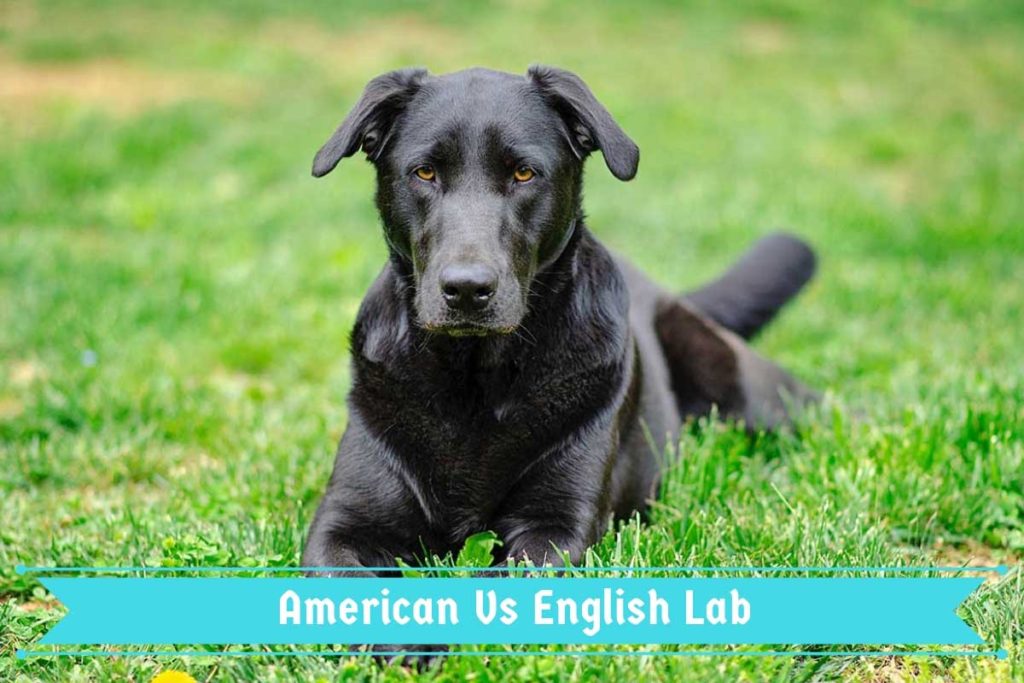
Labrador retrievers are some of the world’s most popular companion dogs – and for good reason. Whether you’re looking to get a Labrador as a family pet, for yourself, or even as a support dog, it’s hard to go wrong when it comes to this friendly breed. But did you know that there are two different types of Labrador retrievers and that there are several differences between the two? Before choosing the lab that’s right for you, it’s helpful to do some research about what the differences are and which kind may be the best fit for you and/or your family. We’re here to take a look at the American vs. the English lab and break down the differences to help you choose the one that’s right for you.
Contents
Why are there two types of Labrador Retrievers?
You may be wondering how there came to be both an American and an English lab. After all, a lab is a lab, right? Both types are great companions that have friendly, happy-go lucky demeanors. The difference is because, historically, they were brought up and raised to have different working purposes which had a bearing on their physical appearance as well as their temperament. This was then passed on genetically to their offspring and throughout the line, regardless of whether or not they were still raised for these specific working conditions. Although some of these differences may not be outwardly obvious, they appear more noticeable if you compare the two.
The history of the Labrador Retriever

As you may be able to guess, the Labrador retriever started as just one type of dog – there was no distinction between American and English. The Labrador retriever originates from Saint John’s, Newfoundland in Canada and were first known to exist in the 1500s. The Labrador breed came into existence by breeding small water dogs with the Newfoundland breed which was meant to create a breed known as the St. John’s Water Dog or the Lesser Newfoundland. At the time, the lab was the go-to waterdog, not only when it came to retrieving game, but retrieving fish as well. The St. John’s Water Dog was commonly owned by fisherman, whose job it was to jump into often icy waters to retrieve fish that had fallen off of their fish hooks, and also to bring in nets full of fish.
The English Lab
The English Lab did not come to be until nearly 3000 years later in the early 1800s. The Earl of Malmesbury witnessed these dogs in action and imported them back home to Poole, England. The breed quickly earned a reputation for being extremely fast, quick swimmers. They were great for fighting and the best at retrieving game from shooting. At this time, the breed was mostly black and had short, smooth hair. When the Earl and Duke of Malmesbury began to use these dogs in shooting sports, they coined the name “Labrador” dogs. Soon after, the Earl’s son began breeding these dogs and, by 1903, the Labrador Retriever was officially recognized by the English Kennel Club. These days, English labs are primarily bred for show.
The American Lab
Americans learned of the hard-working Labrador retriever in the early 1900’s, where they started to become popular hunting and working dogs as well as family pets. By the year 1917, the Labrador retriever was officially recognized by the American Kennel Club. Modern day American Labs primarily refer to those that continue to be bred as hunting and working dogs but, of course, are incredibly popular as family pets.
Differences between the English Lab and the American Lab
There is no official difference between the English Lab and the American Lab in terms of title – they are recognized as the same dog by both the English Kennel Club and the American Kennel Club. However, there are some obvious distinctions between the two that can be seen by simply glancing at them side by side.
Physical
English
There’s a distinct difference in the physical appearance of the English Lab and the American Lab. When it comes to the English Lab, you can see why these dogs are generally described as “stocky”. English Labs are medium-sized dogs that are heavy in appearance due to the size of their necks, wider bodies, and even their large heads. They also have short legs which is what gives them their stocky appearance. Their coat is thicker than an American Lab, adding to their broad appearance, and they have a thicker, straighter tail. Their tail is said to be helpful when it comes to swimming through water, which most labs seem to be naturally gifted for, due to their history. When you think of the Labrador retriever, the English breed is likely what will first come to mind because the English breed are now primarily show dogs that need to stick to the traditional breed standards.
American
While both dogs are classified as a medium sized dog, the American lab is slimmer with more of an athletic frame. Their body structure seems to be smaller boned in general. Even their skulls are narrower with a longer neck and longer muzzles. The coat of the American lab is also thinner than that of the English version and they tend to have a thinner tail that is likely to curl. The American lab is not described as stocky by any stretch of the imagination as they also have longer legs that give them a taller appearance than the English lab.
Temperament
American
There are a few known differences between the temperament of American and English labs. Labrador retrievers in general have excellent temperaments and are exceptionally good-natured dogs. When it comes to the American lab, though, they tend to be more energetic with higher energy levels, due to their history as working dogs. Their athletic build also supports their high-energy lifestyle as they’re typically more energetic and agile than the English labs, who are shorter and stockier. American Labs require a home where they will get all the exercise they need as well as the right amount of stimulation. If you don’t enjoy being active and have no intention of engaging in an active lifestyle, the American lab may not be for you. Unfortunately, there have been many cases of a family adopting a lab puppy because they’re looking for a good-natured pet only to have to give them up because they don’t have the time or energy to devote to making sure their new lab gets enough exercise or play time. If a new dog or puppy has endless amounts of energy and is not exercised properly, they’re going to get into mischief inside the house by getting into things they shouldn’t, having accidents, and chewing up your new shoes. American Labs are also said to be more curious and sometimes more playful than the English lab.
English
Similarly to the American lab, the English lab’s temperament and needs take after their history and physical build. Their shorter, stockier build indicates that they don’t require as much exercise as the American lab and, therefore, do not have quite as much energy. This is also true because they were bred based on appearance due to their history as show dogs whereas the American version was meant to be physically active. English labs are also more calm, quiet, and mellow than their American counterparts which is especially evident after they’ve gone through puppyhood. English labs are still very playful dogs and are very sociable with both people and other dogs. Even though English labs do not necessarily need as much exercise as the American lab, they still need to be exercised well throughout the day and are still not a good choice if you’re not willing to get out and be active with them.
Training
American

When it comes to training, it should come as no surprise that American labs need a little bit more work than the English. Not only do American labs have more energy but they also tend to be quite nervous, requiring more attention and positive reinforcement. If hunting is indeed not a part of why you wanted a Labrador as part of your family, their hunting instinct is going to need to be trained out of them as best you can – which may present difficulties. Hunting may very well always be part of your lab’s instincts but you’re should do what you can to make sure that they’re not lunging at squirrels whenever you want to take them for a walk. The good news? American labs are also quick learners and are very responsive to commands.
English
English labs have less energy than American labs so they’re often considered easier to train, though that’s not necessarily the case. Both the English and American lab have pros and cons when it comes to training. Although training out the hunt instinct isn’t as important as it is it with the American lab, English labs are easily distracted and don’t have the same drive for training that American labs do. This doesn’t make any difference as to whether or not you should train either type of lab – both types of labs need training. It is recommended that you start puppy classes at eight weeks if your pup is cleared medically to do so. Both training and socialization are essential for all Labrador retrievers.
Which type of Labrador retriever should I choose?
When it comes down to it, which lab you choose largely depends on personal preference in terms of their physical traits and how much energy you have to devote to them. Regardless of which you choose, make sure you have the time and energy to train a Labrador, especially so if get a Labrador puppy. The last thing you want is to get a Labrador retriever because you’ve heard that they’re good family dogs and like the look of them only to find out that you just don’t have the time to devote to training them. This is why you see many labs in animal shelters and it’s not fair to either you or the dog. Any dog you decide to adopt should be researched thoroughly so nobody has to go through any unnecessary pain and loss.When it comes down to it, Labrador retrievers are excellent family pets and are loyal, smart, devoted animals. If you have the time and energy to devote to on, as well as the resources to keep it fed, safe, and happy, we’d highly recommend a lab. While they were traditionally black with short hair, both the American and the English lab can be found in beautiful shades of black, brown, and yellow. If you and your family love to spend time outdoors, go on hikes, and play around in the backyard, either type of lab may be right for you.
I grew up in a household that was filled with animals. I believe that my fate as a dog-loving person was sealed in early childhood since my parents owned several dogs of varying sizes and breeds. There was no choice but to take care of and learn about dog habits and the best animal care practices — otherwise, I’d be clueless about how to go about the creatures I was surrounded by day and night.
As a life-long puppy lover, I know a thing or two about dogs and how to go about caring for them in the best way possible. Although I’m not a professionally trained dog behaviorist, trainer, or veterinarian, all of my knowledge and experience with canines comes from a place of love and a deep-rooted passion for dogs and animals in general.
Seeing as dogs kept me company throughout every stage of my life, I decided to follow a different path in my academic life and obtained a Bachelor’s and Master’s degrees in Marketing Management and Digital Advertising, which ultimately allowed me to combine my professional training and personal experience by creating the ultimate dog lover’s resource website! Along with my husband, Dave, I run MySweetPuppy for like-minded dog lovers who want to have a single, clear, and reliable information source about anything and everything related to dogs and their well-being.


